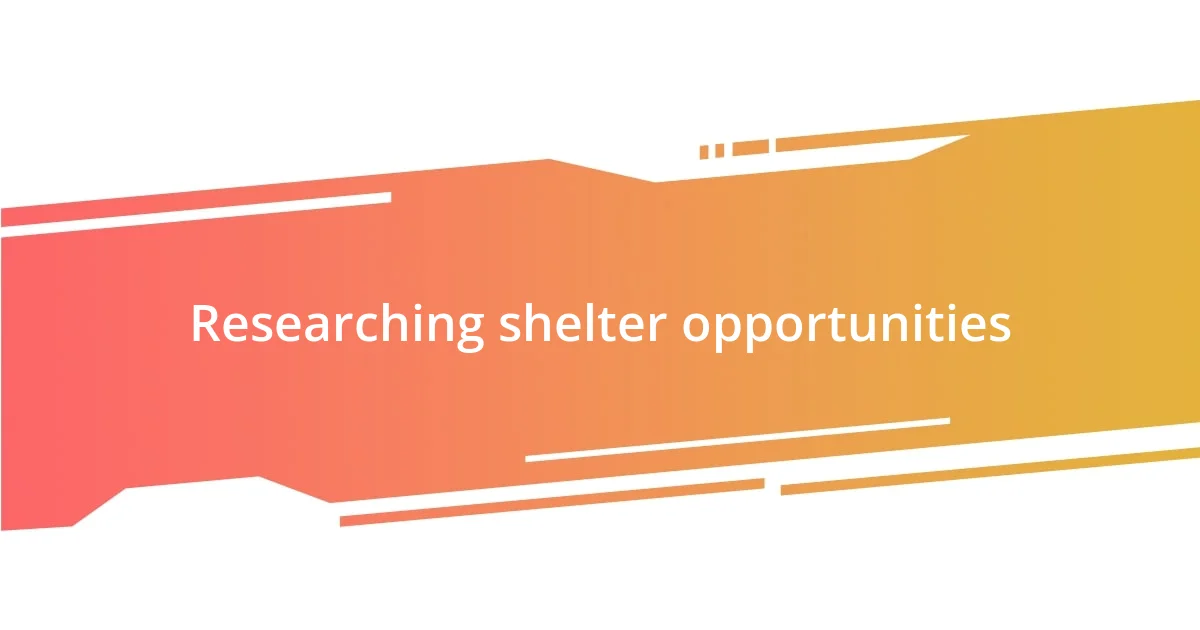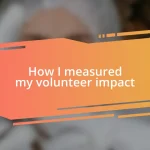Key takeaways:
- Personal transformation through volunteering arises from empathy, connection, and understanding the experiences of those in need.
- Choosing the right shelter involves aligning with personal values, assessing location, mission, and available volunteer programs.
- Building meaningful relationships with fellow volunteers and staff enhances the overall impact and sense of community during the volunteering experience.

My motivation for volunteering
When I first stepped into the shelter, I was overwhelmed by a mix of emotions. It struck me how many people, often just like me, found themselves in difficult situations. I thought, “How would I cope if I were in their shoes?” That question sparked a deep desire within me to lend a helping hand.
One evening, I met a young woman who had just lost her job and her home. With tears in her eyes, she shared her story. As I listened, I realized my simple acts of kindness could mean the world to someone else. It filled me with a sense of purpose that I had never experienced before, making it clear that volunteering was not just about giving back but also about human connection.
Reflecting on my own life, I often think about the times I felt lost or overwhelmed. I remember how little gestures from others made a significant impact on my well-being. Each time I help someone at the shelter, I’m reminded of that important truth: we all need support sometimes, and being able to provide that for anyone is incredibly rewarding.

Choosing the right shelter
Choosing the right shelter can be a pivotal step in your volunteering journey. I remember browsing through various websites, feeling uncertain about where I would fit in. I learned that each shelter has its unique mission and clientele, so I focused on what resonated most with my values.
Here are some key factors to consider when selecting a shelter:
– Location: Choose one that’s convenient for you to access regularly.
– Mission: Research their objectives and see if they align with your personal values.
– Types of services offered: Different shelters provide various support, from food and housing to job training.
– Community involvement: Look for a shelter that actively engages with its local community.
– Volunteer programs: Assess whether they offer structured volunteer opportunities that match your skills and interests.
Finding the right fit can truly enhance your volunteer experience. I was drawn to a local shelter that focused on providing educational resources, as I believe education is a powerful tool for change. The moment I walked through the doors, I felt an instant connection and realized I had made the right choice.

Researching shelter opportunities
Researching shelter opportunities can feel overwhelming at first, especially with so many options available. I vividly remember spending hours online, diving into the missions and activities of various shelters. It was during this process that I discovered how crucial it is to find a shelter that aligns with your own values and interests. For instance, just reading about their initiatives sparked an emotional connection for me, guiding my choice toward a shelter that prioritized education and personal development.
As I sifted through the information, I found it helpful to make a list comparing different opportunities. This method allowed me to visualize which shelters offered programs that resonated with my skills. Engaging with their social media pages was also enlightening; I often found volunteers and staff sharing their experiences, which fueled my excitement. Seeing real-life stories made the idea of volunteering feel tangible and inviting.
Here’s a simple comparison to illustrate some factors I considered while researching different shelters:
| Factor | Shelter A | Shelter B | Shelter C |
|---|---|---|---|
| Location | Downtown | Suburbs | Rural |
| Mission | Hunger Focus | Education and Youth | Homeless Support |
| Volunteer Programs | Flexible Shifts | Structured Workshops | Group Events |
| Community Engagement | Active Part | Monthly Events | Seasonal |
Comparing these elements helped me strategically narrow my options, ensuring that my volunteering would not only be meaningful but also enjoyable. Embracing this research phase not only informed my decision-making but also deepened my commitment to make a positive impact in my community.

Preparing to volunteer effectively
Preparing to volunteer effectively starts well before you even step foot in a shelter. I remember feeling a mix of excitement and nervousness as I prepared to begin my journey. One key aspect is to clarify your own goals and motivations. For instance, ask yourself: What do I hope to gain from this experience? Understanding my intentions not only helped me choose the right shelter but also shaped the energy I brought to the volunteer work itself.
Next, I found that tangible preparation made a huge difference. I took time to gather essential supplies, such as comfortable clothing, a notebook for jotting down insights, and even snacks! Simple things like this allowed me to focus on the tasks at hand without distraction. I also considered researching any specific protocols the shelter had, as being informed made me feel more confident and ready to contribute effectively on my first day.
Lastly, tapping into existing resources and connecting with current volunteers offered me valuable insights that I didn’t find elsewhere. I remember reaching out to someone who had been volunteering longer than I had, and their tips were like gold. They gave me pointers on the best times to come in and essential tasks that required extra hands. It made me wonder—what wisdom can you glean from those already involved? Building those connections not only enriched my preparation but also fostered a sense of community, which is incredibly rewarding in a volunteering context.

Making meaningful connections
I truly believe that volunteering at shelters goes far beyond the tasks at hand; it’s about the relationships you build along the way. I still remember the first time I met other volunteers. We worked side by side to organize donations, and in between sorting through boxes, we shared our stories. Those casual conversations opened a window into different lives, and I felt an instant sense of connection—a camaraderie that sparked my motivation to return. Isn’t it fascinating how shared efforts can forge friendships that initially might seem unlikely?
As I continued my journey, I found that these connections became a source of support. In one instance, there was a volunteer who had been through hardships similar to those we were helping. Her perspective was enlightening; she reminded me that our work wasn’t just about the immediate impact but also about understanding the experiences of others. This shared empathy transformed my volunteering into a deeper engagement. Have you ever found that talking to someone with similar struggles can change your viewpoint? I know it did for me.
Moreover, building relationships with the shelter staff took my experience to another level. When I first approached a coordinator to express my interest, I could sense her passion for the shelter’s mission. Her enthusiasm was contagious, and it made me feel valued right from the start. I began to appreciate not only the work we were doing but also the people’s lives we were touching. By nurturing these connections, I discovered a network of like-minded individuals, all committed to making a difference. It really made me wonder—how can we harness the power of these connections to create even greater positive change in our communities?

Learning from my experiences
Reflecting on my experiences in volunteering, I often find myself learning in ways I didn’t expect. For instance, one day while helping to feed the animals, I noticed how each creature responded uniquely to being cared for. It struck me just how much they craved compassion and understanding. This small lesson underscored the value of empathy in our work—something I think often gets overlooked. Have you ever realized that a simple act of kindness can resonate more than we realize? It certainly did for me.
As I tackled various tasks at the shelter, I came to appreciate the importance of adaptability. One afternoon, when a major adoption event required all hands on deck, I was suddenly thrust into a whirlwind of excitement and chaos. It dawned on me that being flexible wasn’t merely helpful—it was essential. I learned that sometimes, the experiences that push us out of our comfort zones lead to growth. Can you recall a moment when embracing the unexpected changed your perspective? I know I will always cherish those frantic, yet joyful moments.
Moreover, I discovered that volunteering teaches you as much about yourself as it does about others. I vividly remember feeling overwhelmed during my first week, questioning if I truly belonged there. Yet, with each passing day, I found a sense of purpose unfold within me. I realized that my contributions didn’t need to be monumental; they simply needed to come from the heart. Isn’t it freeing to acknowledge that even small actions create ripples of change? Understanding my own capacity to impact others’ lives became one of the most fulfilling revelations in my journey.















